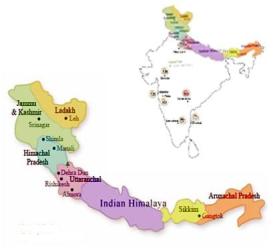

Himalaya Map
India: Call for low-cost Solar Water Heaters in Himalayan Region
 The current use of Solar Water Heaters (SWHs) in India’s Himalayan region remains rather limited, if not scarce. Including Jharkhand, the region’s total installed collector area has been estimated at around 33,000 m2 until the end of 2010, which is less than 1% of the total installed SWH capacity in the country. Most of the existing systems are part of commercial and institutional buildings, whereas the domestic sector makes very little use of SWHs. These are some of the results of the study “Market assessment of solar water heating systems in the Himalayan Region” carried out by Greentech Knowledge Solutions on behalf of the United Nations Development Programme (UNDP) and the Global Environment Facility (GEF).
The current use of Solar Water Heaters (SWHs) in India’s Himalayan region remains rather limited, if not scarce. Including Jharkhand, the region’s total installed collector area has been estimated at around 33,000 m2 until the end of 2010, which is less than 1% of the total installed SWH capacity in the country. Most of the existing systems are part of commercial and institutional buildings, whereas the domestic sector makes very little use of SWHs. These are some of the results of the study “Market assessment of solar water heating systems in the Himalayan Region” carried out by Greentech Knowledge Solutions on behalf of the United Nations Development Programme (UNDP) and the Global Environment Facility (GEF).
Figure: Greentech Knowledge Solutions
The northern Himalayan region, consisting of the states of Jammu and Kashmir, Uttarakhand, and Himachal Pradesh, has a generally better solar radiation availability and more SWH systems than the eastern and north eastern part of the region, which is made up of the states of Jharkhand, Sikkim, Tripura, Meghalaya, Mizoram, Manipur, Nagaland, Arunachal Pradesh and the hilly districts of West Bengal. Find the 250-page study that was published in January 2011 attached for download.
- The main barriers preventing the use of SWH systems in the Himalayan region are as follows:
In several parts: Low solar insolation of up to 4 kWh/m2/day for a maximum of 150 days a year
- Small capacity requirements
- Lack of local manufacturing
- Highly subsidised electricity tariffs resulting in longer payback periods for SWHs
- Low purchasing power of local customers
- Technical problems due to frost in colder regions
- Difficulties in installing conventional SWH systems on sloping roofs made of metal sheets, stone tiles, etc.
- Difficulties in transporting systems to remote areas
- Lack of piped water supply and water quality, particularly when it comes to silt and hardness
- Poor awareness across states and segments, except perhaps the hotel segment
In its study, Greentech identifies 15 Himalayan region districts which offer high market potential. The paper has outlined several measures which could boost SWH market development:
- Creating awareness across the institutional sector with respect to the benefits of SWHs through focused seminars, campaigns and study tours in all major, potential districts
- Facilitating delivery of bank credits through low-interest loans, particularly for small-capacity systems
- Conducting training and capacity-building programmes for local technicians, dealers and manufacturers, in order to ensure proper installation and maintenance of SWHs.
- Developing low-cost domestic solar water heaters to attract a maximum number of residential customers.
- Mandatory regulations for all government, public sector and industrial buildings
The hot water requirement in hotels itself is estimated at around 53,000 m2 for some of the major tourist/religious spots in the Himalayan region. Under the Business As Usual (BAU) and Optimistic scenarios, the expected potential of SWHs is shown in the table below:
| Cumulatively installed collector area in the Himalayan region (m2) | 2010 | 2013 | 2017 | 2022 |
| BAU | 33,256 | 74,374 | 115,537 | 200,493 |
| Optimistic-II | 33,256 | 74,374 | 497,350 | 1,149,970 |
Source: Greentech Knowledge Solutions


